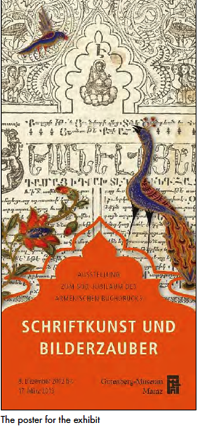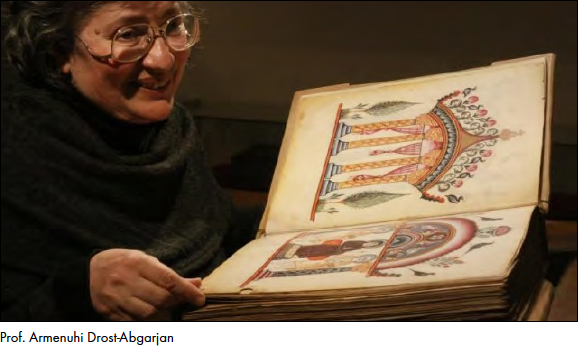Gutenberg Museum Displays Armenian Book Treasures

By Muriel Mirak-Weissbach
Special to the Mirror-Spectator – SATURDAY, FEBRUARY 9, 2013
http://www.mirrorspectator.com/pdf/020913.pdf
MAINZ, Germany — The relationship of Armenians to their language is very special, actually unique. To my knowledge, Armenia is the only country that offers the foreign visitor a monument composed of giant letters of the alphabet, standing as stone sculptures in a vast field outside Yerevan. And Mesrob Mashtots (360-440), the genius who invented the alphabet as a perfect phonetic system in the year 405 AD, is not only honored as a great intellectual but is revered as a canonized saint. His biographer Koriwn compared his arrival in Echmiadzin with his alphabet to the appearance of Moses with the holy tablets from Mount Sinai. Mesrop and his students are honored in the church calendar, especially with the celebration of the Festival of the Holy Translator, again a unique event.
The reason why Armenians reserve such a privileged place for their language lies in the historical fact that it, along with the church, was what saved the Armenian people and their culture from extinction over centuries. Though their nation was occupied by foreign powers, The poster for the exhibit and the people were expelled from their native lands, they managed to maintain their identity as a people thanks to the continuity of their language culture. And a crucial factor in preserving this tradition was the Armenians’ adoption of the technology of book printing invented by the great German scientist Johannes Gutenberg. In fact, the Armenians were among the first Christians of the Orient to print books. That was in 1512, and last year, UNESCO commemorated the 500th anniversary by designating Yerevan officially as the world book capital.
In the context of these anniversary celebrations, exhibits of Armenian book printing were organized in Yerevan, Venice, Amsterdam and Washington, DC. A very special additional exhibit opened in December in Mainz, Germany, and will run through the middle of March. The site of the exhibit is the Gutenberg Museum, dedicated to the life and work of Johannes Gutenberg, who was the first to develop the technology of movable print in ca. 1439, a technology which was to unleash a revolution in learning worldwide. The exhibit, “Schriftkunst und Bilderzauber,” (The Art of Calligraphy and the Charm of Pictures), is modeled on an earlier exhibit in the Artistic Forum in Halle and is organized in cooperation with the Berlin State Library (Staatsbibliothek zu Berlin -Preussischer Kulturbesitz) and the MESROP Center for Armenian Studies at the Martin Luther University in Halle-Wittenberg. The precious books and other artifacts for the exhibit came on loan from the Berlin State Library, which houses the most important collection of early Armenian printed works in all of Europe as well as the largest number of Armenian manuscripts in Germany. Other institutions that made books available are the Library of the German Oriental Society, the National Library of the Republic of Armenia and the Mashtots-Matenadaran Manuscript Institute in Yerevan. The Bavarian State Library in Munich and the Halle Saalesparkasse Foundation also contributed articles for the show. It was the financial contribution of the Armenian government that made the exhibit possible.
And what a wonderful exhibit! With a generous display of artifacts, especially printed books and beautifully illustrated manuscripts, and explanatory panels, the organizers have succeeded, with great economy of means, in giving an overview not only of the beauty and brilliance of the Armenian art of book printing but also of its significance as a contribution to world civilization. The scientific value of Mesrop’s alphabet is explained as well as the political conditions under which the Armenian people struggled; thus the visitor is able to grasp the reason why the Armenian script, the language and its literary tradition (religious as well as profane) gained such importance that a veritable “book cult” developed. Armenians cherish their books like the Bible. Books were not objects but “fellow citizens” and “soldiers,” we read in the accompanying pamphlet. This also helps explain the extraordinary love and care dedicated to producing the magnificent books on display — from the very first book in Armenian printed in movable type, the 1512 Venice edition of Ovorbatagirk’ (Friday Book) of Hakob Megapart, to the translations of the Bible, whose illustrations maintain a continuity with the art of hand illustrated manuscripts from the earliest times. The value of other Armenian translations is evident in the books that transmitted the works of the ancient Greeks, many of which survived only through these early versions in Old Armenian.

The vanguard role of the church in promoting printing is impressive. From the 16th century, Echmiadzin led the effort to preserve the national language and religion through book printing, and the clergy continued to be active in the publishing field. In the 17th and 18th centuries, Armenian works were printed in European centers, Rome, Amsterdam and Venice. From the late 17th century Venice developed as a special center of Armenian book printing, through Italian and Armenian printers as well as through the Mekhitarist Order of Priests on the Venetian island of San Lazzaro, who established their own printing press in 1789. Other centers of Armenian printing documented in the exhibit are Constantinople, Saint Petersburg, Persia, Madras,
Calcutta and so forth. Why such an exhibit should be hosted in Mainz, Germany deserves special mention. Obviously, the fact that after all Gutenberg was the one who made such book printing on a mass scale possible is important. And certainly Gutenberg would have been delighted to see such a magnificent exhibit in the museum dedicated to his work. But there is more to it. Germany, the nation of “poets and thinkers,” is also the home of the greatest philologists of the modern era. Leibniz, Bopp, the Grimm brothers, Humboldt are just a few names associated with this illustrious school, names known outside Germany.
Less well known but just as important in the history of philology are the German scholars who dedicated their efforts to the study of Armenian. The Gutenberg Museum exhibit includes books by Germans who wrote about the Armenians and studied their language.
Hans Schiltperger, for example, presented a report on the Armenians in a book published in Augsburg in 1476. A Bavarian nobleman, Schiltperger was captured by Turks in the battle of Nikopolis (1396), then fell into the hands of the Mongols and was taken through Asia Minor, Syria, Egypt, Persia, Turkmenistan, and Armenia. After being freed in 1427, he wrote up his adventures in a travelogue, a copy of which is on display in Mainz. Then there was Bernhard von Breydenbach, a canon in Mainz who undertook a journey through the Holy Land together with Erhard Reuwich, a painter from Utrecht. His account of the pilgrimage, the Peregrinatio in Terram Sanctem, published in 1486 in Mainz, reported on the Armenian community he met in
Jerusalem. It was the first illustrated travelogue, and was so popular it went through eight editions in various languages in the 15th century.
Also exhibited under glass in Mainz is the Abdias hayeren id est Obadias Armenus primum in Germana specimen characterum Armenicorum, in celeberrima Accademia Lipsiens procuratorum. This book, issued in Leipzig in 1680 by Andreas Acoluth, is the first German edition of this work, and is quite extraordinary. There are seven pages of text, each divided into three columns, with the transliteration (according to West Armenian), the Armenian text in Armenian script and the Latin translation. There follows a section in which the etymological and theological aspects are researched. Acoluth’s thesis was that the Armenian language might be related to Egyptian, an idea which would be further investigated in the 19th century. Acoluth worked together with the Armenian priest Grigorients in Leipzig and had Armenian letters for printing produced at his own expense. His work is considered the beginning of Armenian philology (Armenology) in Germany. On exhibit are also the Thesaurus Linguae armeniscae, published in 1711 by the Marburg Orientalist Johann Joachim Schroeder.
The German scholar who laid the foundations for Armenian philology in the modern era was Heinrich Huebschmann (1848-1908). It was he who first established that Armenian was an independent language within the group of IndoGermanic (or Indo-European) languages, whereas earlier it had been considered a dialect of Iranian. He compiled a grammar and a dictionary of Middle Armenian. Another important German Armenologist was Franz Nikolaus Finck (1867-1910), who issued the Magazine for Armenian Philology beginning in 1901, and who collaborated with Armenian translator Abgar Hovhannesean (1849-1904), who contributed to making Armenian literature known in Germany.
Armenology (Hayagitut’iwn), the study of Armenia, its language, religion, history and culture, has a long and illustrious history in Germany, which is reflected in the Mainz exhibit. And Armenology is alive and well here. Its leading representative is Prof. Armenuhi DrostAbgarjan, from MESROP, the Center for Armenian Studies at the Martin-Luther University Halle-Wittenberg, who was curator of the exhibit. Working with her to create this wonderful show are Meliné Pehlivanian, from the Berlin State Library, Prussian Cultural Heritage, Orient Department, and Dr. Annette Ludwig, director of the Gutenberg Museum. They also prepared the brochure for the exhibit, from which material for this article is drawn.

